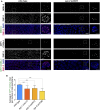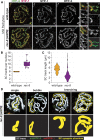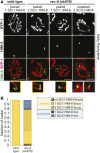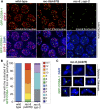Synaptonemal Complex Central Region Proteins Promote Localization of Pro-crossover Factors to Recombination Events During Caenorhabditis elegans Meiosis
- PMID: 31431470
- PMCID: PMC6781886
- DOI: 10.1534/genetics.119.302625
Synaptonemal Complex Central Region Proteins Promote Localization of Pro-crossover Factors to Recombination Events During Caenorhabditis elegans Meiosis
Abstract
Crossovers (COs) between homologous chromosomes are critical for meiotic chromosome segregation and form in the context of the synaptonemal complex (SC), a meiosis-specific structure that assembles between aligned homologs. During Caenorhabditis elegans meiosis, central region components of the SC (SYP proteins) are essential to repair double-strand DNA breaks (DSBs) as COs. Here, we investigate the relationships between the SYP proteins and conserved pro-CO factors by examining the immunolocalization of these proteins in meiotic mutants where SYP proteins are absent, reduced, or mislocalized. Although COs do not form in syp null mutants, pro-CO factors COSA-1, MSH-5, and ZHP-3 nevertheless colocalize at DSB-dependent sites during late prophase, reflecting an inherent affinity of these factors for DSB repair sites. In contrast, in mutants where SYP proteins are present but form aggregates or display abnormal synapsis, pro-CO factors consistently track with SYP-1 localization. Further, pro-CO factors usually localize to a single site per SYP-1 structure, even in SYP aggregates or in mutants where the SC forms between sister chromatids, suggesting that CO regulation occurs within these aberrant SC structures. Moreover, we find that the meiotic cohesin REC-8 is required to ensure that SC formation occurs between homologs and not sister chromatids. Taken together, our findings support a model in which SYP proteins promote CO formation by promoting the localization of pro-CO factors to recombination events within an SC compartment, thereby ensuring that pro-CO factors identify a recombination event within an SC structure and that CO maturation occurs only between properly aligned homologous chromosomes.
Keywords: C. elegans; chromosome axis; cohesin; crossovers; meiosis; recombination; synaptonemal complex.
Copyright © 2019 by the Genetics Society of America.
Figures








Similar articles
-
The synaptonemal complex shapes the crossover landscape through cooperative assembly, crossover promotion and crossover inhibition during Caenorhabditis elegans meiosis.Genetics. 2010 Sep;186(1):45-58. doi: 10.1534/genetics.110.115501. Epub 2010 Jun 30. Genetics. 2010. PMID: 20592266 Free PMC article.
-
C. elegans ZHP-4 is required at multiple distinct steps in the formation of crossovers and their transition to segregation competent chiasmata.PLoS Genet. 2018 Oct 31;14(10):e1007776. doi: 10.1371/journal.pgen.1007776. eCollection 2018 Oct. PLoS Genet. 2018. PMID: 30379819 Free PMC article.
-
A yeast two-hybrid screen for SYP-3 interactors identifies SYP-4, a component required for synaptonemal complex assembly and chiasma formation in Caenorhabditis elegans meiosis.PLoS Genet. 2009 Oct;5(10):e1000669. doi: 10.1371/journal.pgen.1000669. Epub 2009 Oct 2. PLoS Genet. 2009. PMID: 19798442 Free PMC article.
-
New and old ways to control meiotic recombination.Trends Genet. 2011 Oct;27(10):411-21. doi: 10.1016/j.tig.2011.06.007. Epub 2011 Jul 21. Trends Genet. 2011. PMID: 21782271 Free PMC article. Review.
-
Female Meiosis: Synapsis, Recombination, and Segregation in Drosophila melanogaster.Genetics. 2018 Mar;208(3):875-908. doi: 10.1534/genetics.117.300081. Genetics. 2018. PMID: 29487146 Free PMC article. Review.
Cited by
-
Alterations in synaptonemal complex coding genes and human infertility.Int J Biol Sci. 2022 Feb 21;18(5):1933-1943. doi: 10.7150/ijbs.67843. eCollection 2022. Int J Biol Sci. 2022. PMID: 35342360 Free PMC article. Review.
-
Homozygous variants in SYCP2L cause premature ovarian insufficiency.J Med Genet. 2021 Mar;58(3):168-172. doi: 10.1136/jmedgenet-2019-106789. Epub 2020 Apr 17. J Med Genet. 2021. PMID: 32303603 Free PMC article.
-
Crossovers are regulated by a conserved and disordered synaptonemal complex domain.Nucleic Acids Res. 2025 Feb 8;53(4):gkaf095. doi: 10.1093/nar/gkaf095. Nucleic Acids Res. 2025. PMID: 39964475 Free PMC article.
-
Cohesin ring gates are specialized for meiotic cell division.J Mol Cell Biol. 2025 May 2;16(10):mjae047. doi: 10.1093/jmcb/mjae047. J Mol Cell Biol. 2025. PMID: 39401990 Free PMC article.
-
Synaptonemal Complex dimerization regulates chromosome alignment and crossover patterning in meiosis.PLoS Genet. 2021 Mar 17;17(3):e1009205. doi: 10.1371/journal.pgen.1009205. eCollection 2021 Mar. PLoS Genet. 2021. PMID: 33730019 Free PMC article.
References
Publication types
MeSH terms
Substances
Grants and funding
LinkOut - more resources
Full Text Sources
Research Materials

